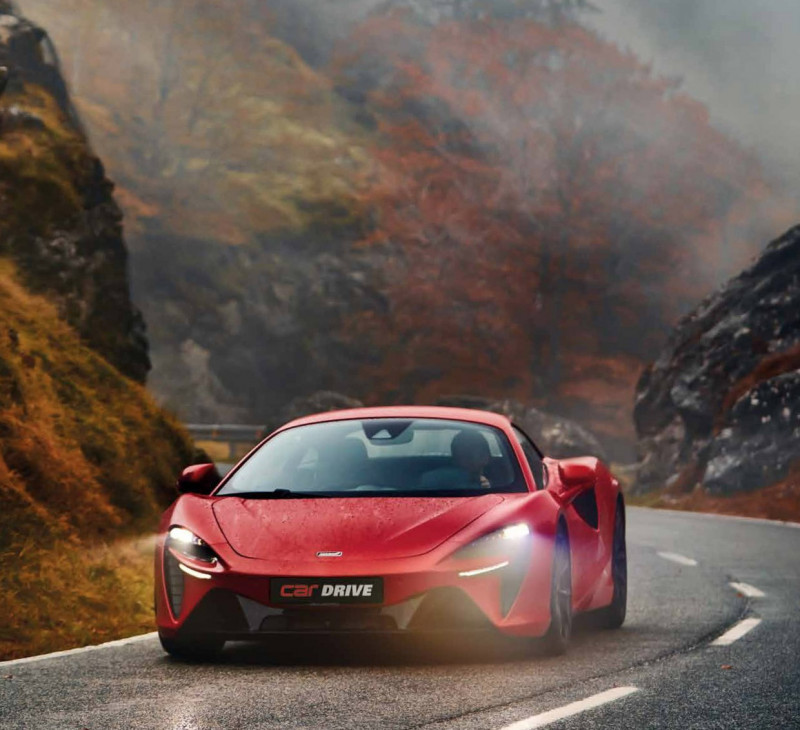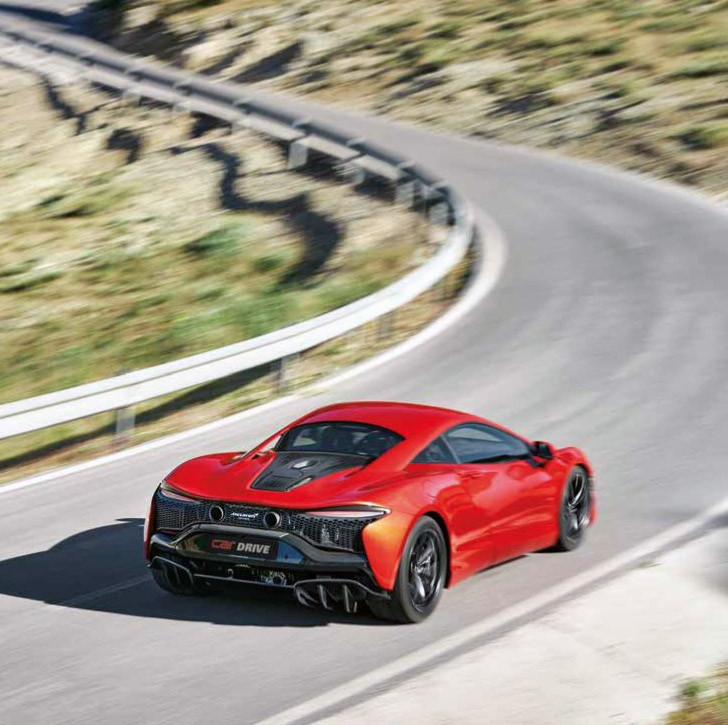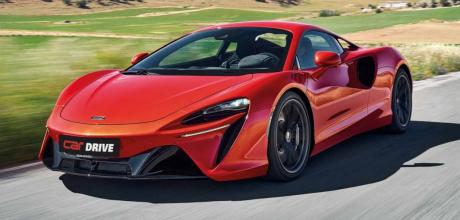2023 McLaren’s electrified Artura supercar
A storm is gathering as we buckle into McLaren’s electrified Artura supercar
McLaren’slightning rod
McLaren has been treading water lately, the constant source of speculation regarding the brand’s future as it experiences both financial and leadership challenges. While all this has been going on, it has been developing its first production-series plug-in hybrid supercar, the Artura. This car is all new from the ground. We first got a look at it all the way back in December 2020; we’ve now driven it – and it’s definitely been worth the wait.

The replacement for the 570S displays McLaren familiarity, something that will appeal to many but may disappoint those expecting it to be game-changing in all aspects. However, it’s what’s beneath the shark-nose and lasercut cooling grilles that impresses us the most. The new McLaren Lightweight Architecture features a carbon-fibre monocoque that is lighter, stronger and stiffer than before. Other features include a new electronic rear diff, 8-speed transmission, ethernet electrical architecture, infotainment system and the most crucial development, a new plug-in hybrid powertrain that consists of a twin-turbo V6 and an electric motor.

The new M630 twin-turbo V6 took five years to develop, but it’s the axial-flux electric motor that’s the centre of attention. As well as providing the reverse gear, it contributes 70 kW and 225 N.m to the combined outputs of 500 kW and 720 N.m. It’s integrated into the housing of the new seamless-shift gearbox and connected to a 7,4 kWh battery in the floor, which combined produces 33% more power than the electric motor in the limited-run P1 hypercar.
There’s another piece of clever tech to discuss here … the brand new Pirelli Cyber Tyres. The Italian tyre maker is working with several car companies on this technology, but it’s debuted on the Artura. A chip embedded in the P-Zero tyre communicates directly with software integrated into the ECU, constantly assessing its condition and environment and advising on how best the tyres should be used.
Effectively, it means the car now knows what shoes it is wearing and what it can do with them. Climb in through the dihedral doors and there’s more familiarity. But at the same time, there are noticeable changes. The steering wheel remains devoid of buttons, because McLaren’s global product manager, Tom Taylor, told us “at McLaren we like to have a clean, uncluttered steering wheel”. Take that, Ferrari. There are paddles, of course, but the controls for the suspension and driving modes are now rockers mounted on either side of the digital instrument cluster housing.
The materials used feel more luxurious, the quality improved, and sitting in either the Comfort or ClubSport seats, there’s a superb level of comfort and attention to detail. The driving position is excellent, providing a level of forward visibility akin to playing a racing simulator. Then it’s time to bring on supercar noise, so you press the start button, all the screens light up, and what’s this? Silence.
When you press the accelerator, though, the Artura moves. This electric thing feels rather un-supercar-like. It’s something we will have to get used to as brands such as Lotus, Nio, Pininfarina Automobili and Rimac debut even more electric performance machinery. That said, it still feels weird, almost eerie and completely unnatural.
Leave it in electric mode and it will glide through town for up to 31 km, while switching to Comfort lets the car decide, depending on speed and acceleration. It’s in this mode that the everyday-supercar element McLaren was so proud of with the MP4-12C becomes evident. Gently ambling through Spanish villages, the Artura soaks up the bumps, lifts its nose at speed humps (there’s an easy-to-use button to do that) and at times slips silently past those enjoying a siesta. You could probably run the Artura as a daily driver if you wanted to, something we normally say only of the Porsche 911.
And there are even more 911 comparisons, starting with the impressive steering. McLaren has avoided going electric, preferring to use a hydraulically assisted steering system, and it’s brilliant.
Porsche has always had the best steering, frustrating the other sportscar makers, but the Artura is a match in terms of its weight, precision and communication between road, car and driver. Combine this with the ride characteristics and you can tick off more 911-like boxes, such as the proactive damper control that contributes to making the suspension compliant enough for scarred tarmac. It allows it to hunker down on twisty roads and when you find yourself on the race track, as we did at Ascari.
In both situations, the Artura continues its attack on the 911, with a level of precision rivals from Ferrari and Lamborghini struggle to match. Every steering input is accurate, the suspension responds to your every demand, the car seems to dance around a central point and the power delivery is spot on. Don’t expect the onslaught of power you will get in its Italian rivals, though. Again, it’s more Porsche-like in its linearity with both elements of the powertrain working together in Sport and Track mode to provide exactly the power you request to build confidence with every lap. On track, the downforce kept it firmly planted, emphasising the compression through the banked Bathurst corner and pulling it to the tarmac as we tackled the revised Pif-Paf chicane. Ascari has been sold, but we really hope this wasn’t the last time we get to experience this phenomenal Spanish track.
That said, Artura impressed the most on the road, though; it ate up the kilometres like a grand tourer and devoured corners like a racecar. Spanish roads can be a little dusty, yet the Artura barely flinched when it was pushed hard, allowing for mid-corner corrections to cope with any approaching traffic, or a sudden slow for one of the many cyclists. You’ll have to excuse the cliché; it’s a car you can feel at one with, perfectly set up, communicative and powerful. It is enormous fun. Still, all is not perfect. We only had one minor electronic issue.
Others were not so fortunate. Two cars had flameouts from the engine a few days before our arrival and two had rear axle lockup on track while we were there. This is not what McLaren needs right now and, while the launch was postponed once already for technical issues with the car, perhaps the Woking operation should have waited a little longer. They have assured us they will fix all these issues before any customer cars are delivered, but it’s not a good start to a crucial new era for the brand.
They need to sort it, because what McLaren has created here is not only one of the best supercars it’s ever made, it’s also one of the best of the genre. It still ticks the everyday-supercar box, perhaps even more so if you have the need to drive to the office in EV mode, but it’s the sportscar character that really shines through. It’s a true driver’s car, one designed and engineered to be as much fun on Franschhoek Pass as it is around a racetrack like Ascari. It’s involving, rewarding and incredibly communicative.
Although McLaren still has a bit of work to do, the new Artura has the potential to do more than just define a new era of electrification for the company: It could define a new era for the supercar as we’ve come to know it.
01 There's familiarity in the design of the Artura that will appeal to some and disappoint others. 02 Rocker switches on the instrument cowl theatrically change suspension and drive modes. 03 The revised infotainment system is thoroughly modern and includes a page to monitor the low-profile Pirelli Cyber Tyres. 04 There's a choice of Comfort or these lightweight ClubSport seats, where grippy suede inserts help to keep you in place. 05 LED headlights feature a new design. 06 Plug it in and the Artura can be charged to 80% in around 2,5 hours.
01 Laser-cut grilles surround the exhausts, providing a slightly muted tone for a McLaren, especially when compared to the distinctive V8 we’ve come to know.
02 Functional louvres above the front wheels channel air to the side ducts, one of many aero tweaks. 03 McLaren has upped its game when it comes to interior design and quality and remains driver focused.
- Price: R4,9 million
- Engine: twin-turbo petrol V6, plug-in hybrid electric
- Transmission: 8-speed SSG automatic
- Max Power: 500 kW @ 7 500 r/min
- Max Torque: 720 N.m @ 2 250 r/min
- 0–100 km/h: 3,0 seconds*
- Top speed: 330 km/h*
- Fuel consumption: 4,6 L/100km
- CO2: 104 g/km
- Rivals: Ferrari 296 GTB, Lotus Emira, Maserati MC20, Porsche 911 992
- + power delivery, everyday comfort, incredible grip
- - technical issues are disappointing


